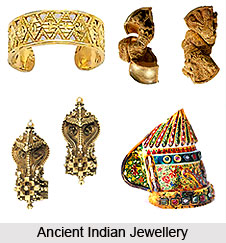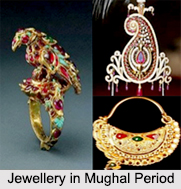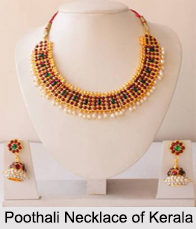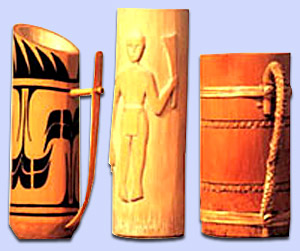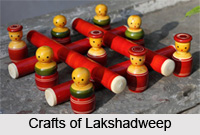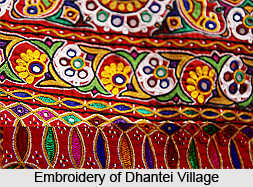Stone Crafts of Central India encompasses an arcade of stone handicrafts, much influenced by the regional influences. The stone crafts of Madhya Pradesh demonstrate the highly acclaimed tradition of stone carving that commenced in the medieval era with the royal patronage and they bring the amalgamated long lost flavours artistry and folk art mirroring the simplicity and intensity of the natives.
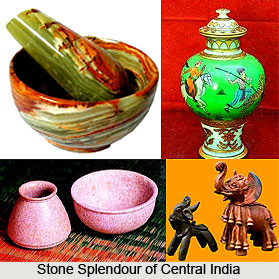 The basic stone that has been used in most of the stone crafts of Madhya Pradesh is soapstone. This particular stone is used mainly for shaping and carving idols. There are many villages in Bastar which have shrines with stone idols. The villages of Bade Dongar, Chotta Dongar, Dantewada, Narangpal, Bastar, Kondagaon, Chapka and Amravati are well admired for the stone shrines that reflect immense dexterity. The artisans of these areas create idols of tribal gods and goddesses like Budhi Mai, Danteshwai, Khanda Kanalin, Phiranta Mata, Jhitku-Mitki, Banga Ram, Andhar Devi, Sendia Mata, Mavli Devi and Rao Dev. These are the important deities of the tribal people namely the Muria, Mahara and Rawat communities.
The basic stone that has been used in most of the stone crafts of Madhya Pradesh is soapstone. This particular stone is used mainly for shaping and carving idols. There are many villages in Bastar which have shrines with stone idols. The villages of Bade Dongar, Chotta Dongar, Dantewada, Narangpal, Bastar, Kondagaon, Chapka and Amravati are well admired for the stone shrines that reflect immense dexterity. The artisans of these areas create idols of tribal gods and goddesses like Budhi Mai, Danteshwai, Khanda Kanalin, Phiranta Mata, Jhitku-Mitki, Banga Ram, Andhar Devi, Sendia Mata, Mavli Devi and Rao Dev. These are the important deities of the tribal people namely the Muria, Mahara and Rawat communities.
The stone crafts of Madhya Pradesh include the usage of different tools like basula, pataasis, guniya, warja, warji and battas. The artisans of Madhya Pradesh create two types of idols viz. tatiya saaj which has two-dimensional relief work and the akshang which is three-dimensional relief work. Meena, the tribals basically from Rajasthan, now residing in Gujarat and Raigarh, create idols of the gods Hanuman, Lord Ganesha and Lord Shiva, and the goddess Parvati that are seen in the parts of western Madhya Pradesh including the gods Pabuji and Tejaji of Rajasthan. These artefacts are found in the districts of Ratlam, Kurkshi and Mandsaur. The popular deities that are stone-crafted include the Gods Bijasan, Bhairav, Hardaul, Karas Deo and Hanuman, and the goddesses, Durga, Kali and Bhawani.
Not only the religious idols but the artisans create items like Mariamaak, as well as paper-weights and pin-stands out of soapstone. The figures of wild animals are also created in Kailaven and Tikamgarh Districts. Even the abundance of the soft marble rocks at Bhedaghat near Jabalpur has facilitated the artisans to create decorative objects like figures, carved panels, and boxes with excellent designs. Even the availability of green stone near Balaghat has benefited the craftsmen to make different items out of it. Moreover the tribal people of these areas create utilitarian items like the mortar and pestle, the silbatta (flat stone used for grinding purposes), chabbi, chakkis, handi(vessel used for cooking rice and vegetables), and chakla(platform used for rolling chapattis) out of stone with beautifully carved designs.
The rock cut temples of Vidisha, the stone sculptures of the temples of Khajuraho, the monuments of Gwalior and Orchha are exemplary of the distinct artistry of the stone carvers of Madhya Pradesh. As each place has its own style and tradition, the stone carving differs from one another. While Gwalior specializes in jalli (lattice) work, Tikamgarh and Jabalpur are famous for decorative items including human figures and statues of animals.
Singi, Mandsaur, Ratlam, and Narsinghagarh are admired for the excellent stone craft in Madhya Pradesh. The artisans of Ghosipura area of Gwalior has been praised for the dexterous sculptors who are considered as the descendants of Vishwakarma. The tribal communities occupy a separate place in the stone crafts of Madhya Pradesh.
Stone crafts of Chhattisgarh are an amalgamation of the tribal culture and the artistry of the local artisans as well. The stone articles created by the tribes are the instances of creative exuberance. These crafts of Chhattisgarh also mirror the simplicity and intensity of the native people. The stone crafts of Chhattisgarh have attained great heights due to the ample availability of good quality stones that can be easily carved and are not fragile. The tradition of the stone crafts in Chhattisgarh has been preserved by the tribal artisans of this place. The availability of the stone called Sudapaal stones, which are pink and white colour in the Bastar region, are hugely used for stone carving as they are soft and easily accessible. The artisans use different tolls like Basulas (stone cutter), chisels called Pataasis etc for stone carving and after the carving is complete the artisans polish the items with sandpaper to give the items a natural gleam. The polishing is also done with stones which are called battas. The artisans create intricate designs with curved motifs. The artisans have a sound knowledge of the sense of measurement and to give the figures the perfect proportion, the artisans use a simple compass like instrument of measurement called Guniya.
The stone crafts of Chhattisgarh involve the participation of the women and children in making the stone items full fledged. Basically men do the main carvings and women and children are engaged in polishing the items. The idols are identified by different names like Tatiya saaj and akshang idols. While the Tatiya saaj idols are carved on a thick rock as two-dimensional relief work, the akshang idols are three dimensional. With their artistry and experience, the artisans create these idols with intricate carvings without any prescribed measurements. The craftsmen create the idols of Hanuman, Ganesha, Shiva, Parvati and sometimes human and animal figures are also created that stand typical of the Chhattisgarh stone carving. Sheopur is a place where a traditional form of stone craft is practiced. This craft is mainly practiced by the tribal people of the area. The tribal artisans also decorate door frames with intricate creeper designs and also make different idols.
